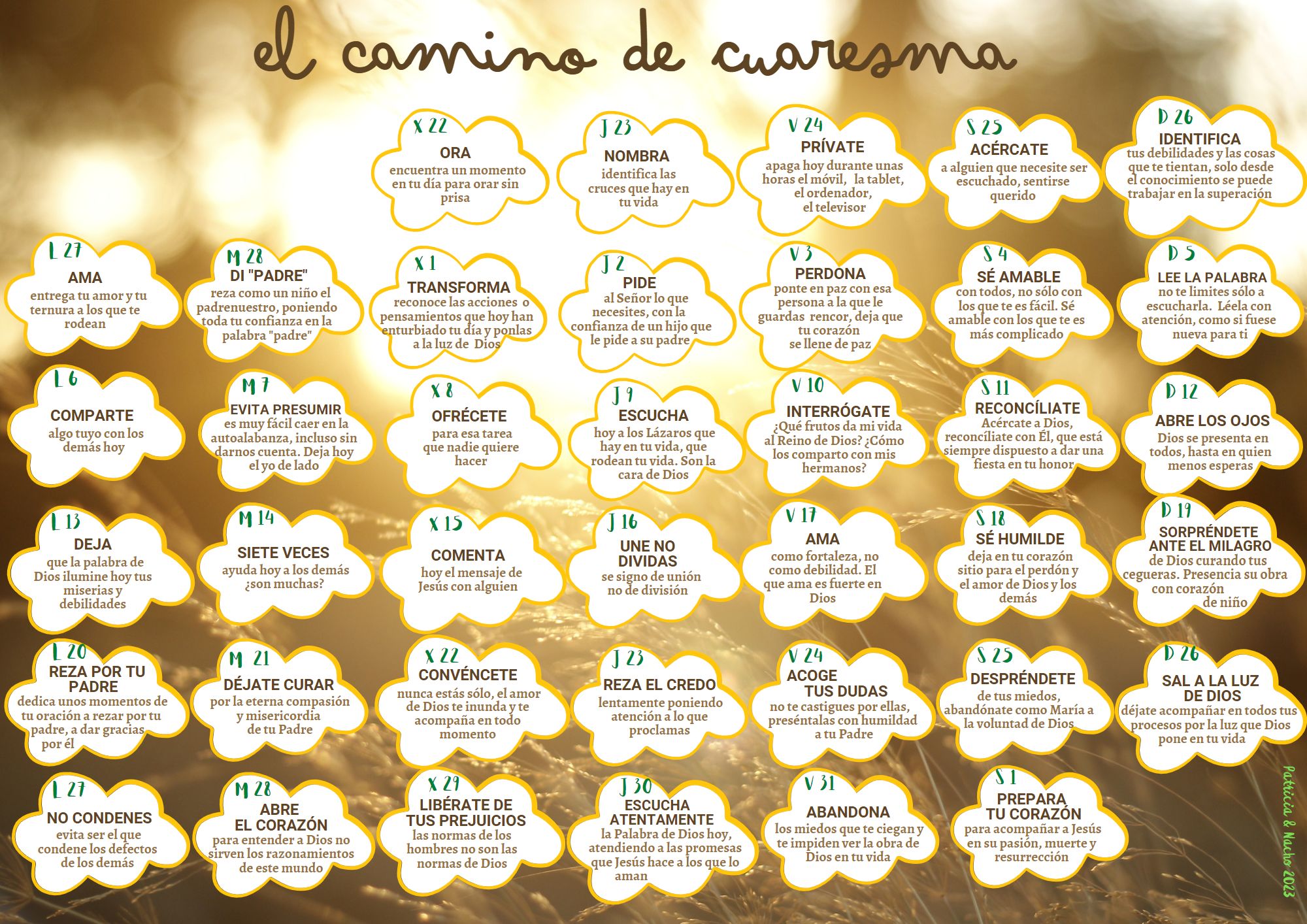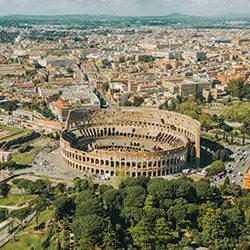"The Church unites herself every year, during the forty days of Great Lent, to the Mystery of Jesus in the desert." Catechism of the Catholic Church, 540.
What is Lent?
The meaning of Lent comes from Latin quadragesima, a liturgical period of forty days reserved for the preparation of Easter. Cuarenta días en alusión a los 40 años que pasó el pueblo de Israel en el desierto con Moisés y los 40 días que pasó Jesús en el desierto antes de iniciar su vida pública.
This is a preparation and conversion time to participate in the culminating moment of our liturgy, together with the whole Catholic Church, which on Wednesday we began with enthusiasm.
In the Catechism, the Church proposes to follow the example of Christ in his desert retreat, in preparation for the Easter solemnities.. It is a particularly appropriate time for spiritual exercisesthe liturgies penitential, penitential pilgrimages as a sign of penitence, voluntary deprivations such as the fasting and the almsand the Christian communication of goods by means of charitable and missionary works.
This effort of conversion is the movement of the contrite heart, attracted and moved by the grace to to respond to the merciful love of God who has loved us first.
Donate now to help form diocesan and religious priests to serve the Church around the world.
"We cannot consider this Lent as just another season, a cyclical repetition of the liturgical season. This moment is unique; it is a divine help to be welcomed. Jesus passes by our side and expects from us - today, now - a great change". It is Christ Who Passes By, No. 59.
When does Lent begin?
The imposition of ashes on the foreheads of the faithful on Ash Wednesday, is the beginning of this road. It constitutes a invitation to conversion and penance. It is an invitation to go through the Lenten season as a more conscious and intense immersion in the paschal mystery of Jesus, in his death and resurrection, through participation in the Eucharist and in the life of charity.
The time of Lent ends on Holy Thursdaybefore Mass in Coena Domini (the Lord's Supper), which begins the Easter Triduum, Good Friday and Glory Saturday.
During these days we look inside ourselves and we assimilate the mystery of the Lord being tempted in the desert by Satan and his going up to Jerusalem for his Passion, Death, Resurrection and Ascension to the Heavens.
We remember that we must convert and believe in the Gospel and that we are dust, sinful men, creatures and not God.
Donate now to help form diocesan and religious priests to serve the Church around the world.
"What better way to begin Lent? We renew faith, hope, charity. This is the source of the spirit of penance, of the desire for purification. Lent is not only an occasion to intensify our external practices of mortification: if we were to think that it is only that, we would miss its deep meaning in the Christian life, because these external acts are - I repeat - the fruit of faith, hope and love". Christ Is Passing By, No. 57.
How to live Lent?
Lent can be experienced through the sacrament of Confession, prayer and positive attitudes.
Catholics we prepare for the key events of the Holy Week through the pillars of the prayer, fasting and almsgiving. These guide us in our daily reflection on our own life while we strive to deepen our relationship with God and with our neighborno matter what part of the world the neighbor lives in. Lent is a time of personal and spiritual growth, a time to look outward and inward. It is a time of mercy.
Repentance and confession
As a time of penitence, Lent is a season of it is a good time to go to confession. It is not obligatory, nor is there any mandate from the Church to do so, but it fits very well with the words of the Gospel that the priest repeats on Ash Wednesday: "Remember that dust you are and to dust you shall return" o "Convert and believe in the Gospel".
In these holy words there is a common element: the conversion. And this is only possible with repentance and a change of life.. Therefore, confession during Lent is a practical way of ask God's forgiveness for our sins and start over again.. The ideal way to begin this exercise of introspection is through an examination of conscience.
Penance
Penance, the Latin translation of the Greek word "metanoia" which in the Bible means the conversion of the sinner. Designates an entire all the interior and exterior acts aimed at the reparation of the committed sinand the resulting state of affairs for the sinner. Literally change of life, it is said of the act of the sinner who returns to God after having been far from Him, or of the unbeliever who attains faith.
Conversion
Converting is reconciliation with GodWe are to turn away from evil in order to establish friendship with the Creator. Once in grace, after confession and what it implies, we must set out to change from within everything that does not please God.
To concretize the desire for conversion, it is possible to do the following conversion workssuch as, for example: Attending the sacramentsto overcome divisions, to forgive and to grow in a fraternal spirit; practicing the Works of Mercy.
Fasting and abstinence
The Church invites its faithful to observance of the precept of fasting and abstinence of flesh, compendium of Catechism 432.
The fasting consists of eating only one meal a day, although it is possible to eat a little less than usual in the morning and evening. Except in case of illness. It invites to live the fast, to all the adults, until they are fifty-nine years old. Both on Ash Wednesday and Good Friday.
It is called abstinence to abstain from eating meat on Fridays of Lent. The abstinence can begin from the age of fourteen.
Care should be taken not to live fasting or abstinence as a minimum, but as a concrete way in which our Holy Mother Church helps us to grow in the true spirit of penance and joy.
Donate now to help form diocesan and religious priests to serve the Church around the world.

Proposed calendar of resolutions to live Lent.
Holy Father's Message for Lent 2024
Through the wilderness God leads us to freedom
"Dear brothers and sisters:
When our God reveals Himself, He communicates freedom: "I am the Lord, your God, who brought you out of Egypt, out of a place of slavery" (Ex 20,2). Thus opens the Decalogue given to Moses on Mount Sinai. The people know well what exodus God is talking about; the experience of slavery is still imprinted on their flesh. They receive the ten words of the covenant in the desert as the way to freedom. We call them "commandments", underlining the power of the love with which God educates his people. The call to freedom is, in fact, a vigorous call. It is not exhausted in a single event, because it matures along the way. Just as Israel in the desert still carries Egypt within her - indeed, she often misses the past and murmurs against heaven and Moses - so too today the people of God carry within them oppressive bonds that they must decide to abandon. We become aware of this when we lack hope and wander through life as in a desolate wasteland, without a promised land towards which we can walk together. Lent is the time of grace in which the desert once again becomes - as the prophet Hosea announces - the place of first love (cf. Os 2,16-17). God educates his people to abandon their slavery and experience the passage from death to life. As a bridegroom he draws us back to himself and whispers words of love to our hearts.
The exodus from slavery to freedom is not an abstract path. In order for our Lent to be concrete, the first step is to want to see the reality. When at the burning bush the Lord drew Moses and spoke to him, he immediately revealed himself as a God who sees and above all hears: "I have seen the oppression of my people, who are in Egypt, and I have heard the cries of pain, caused by their taskmasters. Yes, I am well acquainted with their sufferings. That is why I have come down to deliver them from the power of the Egyptians and to bring them up out of that land to a land that is fertile and spacious, to a land flowing with milk and honey" (Ex 3,7-8). Today too, the cry of so many oppressed brothers and sisters reaches heaven. Let us ask ourselves: does it also reach us, does it shake us, does it move us? Many factors distance us from one another, denying the fraternity that unites us from the beginning.
On my trip to Lampedusa, faced with the globalization of indifference, I asked two questions, which are becoming more and more topical: "Where are you?" (Gn 3,9) and "Where is your brother?" (Gn 4,9). The Lenten journey will be concrete if, listening to them again, we confess that we are still under the dominion of Pharaoh. It is a dominion that leaves us exhausted and makes us insensitive. It is a model of growth that divides us and robs us of the future; that has polluted the earth, the air and the water, but also souls. For although our liberation has already begun with baptism, there remains in us an inexplicable longing for slavery. It is like an attraction to the security of what we have already seen, to the detriment of freedom.
God is moved
I would like to point out a detail of no small importance in the story of the Exodus: it is God who sees, who is moved and who liberates, not Israel who asks for it. Pharaoh, in fact, destroys even dreams, steals the sky, makes a world in which dignity is trampled underfoot and authentic bonds are denied, seem unchangeable. In other words, it succeeds in keeping everything subject to it. Let us ask ourselves: do I desire a new world, and am I willing to break my commitments to the old one? The witness of many brother bishops and of a great number of those who work for peace and justice convinces me more and more that what needs to be denounced is a deficit of hope. It is an impediment to dreaming, a mute cry that reaches to heaven and touches the heart of God. It resembles that longing for slavery that paralyzes Israel in the desert, preventing it from moving forward. The exodus can be interrupted. Otherwise it would not be explained that a humanity that has reached the threshold of universal fraternity and levels of scientific, technical, cultural and legal development, capable of guaranteeing the dignity of all, walks in the darkness of inequalities and conflicts.
God never tires of us. Let us embrace Lent as the powerful time in which his Word addresses us once again: "I am the Lord your God, who brought you out of Egypt, out of a place of slavery" (Ex 20,2). It is a time of conversion, a time of freedom. Jesus himself, as we remember every year on the first Sunday of Lent, was led by the Spirit into the desert to be tested in his freedom. For forty days he will be before us and with us: he is the Son incarnate. Unlike Pharaoh, God does not want subjects, but sons. The desert is the space in which our freedom can mature into a personal decision not to fall back into slavery. In Lent, we find new criteria of judgment and a community with which to embark on a path we have never traveled before.
You are my beloved Son
This implies a struggleThe book of Exodus and the temptations of Jesus in the desert tell us clearly. To the voice of God, who says: "You are my beloved Son" (Mc 1:11) and "you shall have no other gods before me" (Ex 20:3), the lies of the enemy are in fact opposed. More fearsome than Pharaoh are the idols; we could consider them as his voice in us. Feeling omnipotent, recognized by all, taking advantage over others: every human being feels within himself the seduction of this lie. It is a well-worn path. Therefore, we can become attached to money, to certain projects, ideas, objectives, to our position, to a tradition and even to some people. Those things instead of driving us, will paralyze us. Instead of uniting us, they will pit us against each other. There is, however, a new humanity, that of the small and humble who have not succumbed to the charm of lies. While idols render mute, blind, deaf and immobile those who serve them (cf. Salt 115:8), the poor in spirit are immediately open and well disposed; they are a silent force for good that heals and sustains the world.
It's time to act, and in Lent to act is also to stop. Stop at prayerto welcome the Word of God, and to stop like the Samaritan, before the wounded brother. Love of God and love of neighbor is one love. To have no other gods is to stop before the presence of God, in the flesh of one's neighbor. This is why prayer, almsgiving and fasting are not three independent exercises, but a single movement of opening, of emptying: away with the idols that weigh us down, away with the attachments that imprison us. Then the atrophied and isolated heart will awaken. Therefore, slow down and stop. The contemplative dimension of life, which Lent will help us rediscover, will mobilize new energies. Before the presence of God we become sisters and brothers, we perceive others with new intensity; instead of threats and enemies we find companions and fellow travelers. This is God's dream, the promised land toward which we march when we leave slavery.
The synodal form of the Church, which in recent years we have been rediscovering and cultivating, suggests that Lent should also be a time of community decisionsI invite all Christian communities to do this: to offer their faithful moments to reflect on their lifestyles, to take time to verify their presence in the neighborhood and their contribution to improving it. I invite all Christian communities to do this: to offer their faithful moments to reflect on lifestyles; to take time to verify their presence in the neighborhood and their contribution to improving it. Woe to us if Christian penance were like that which saddened Jesus. He also says to us: "Do not look sad, as do the hypocrites, who disfigure their faces so that it will be seen that they are fasting" (Mt 6,16). Rather, let joy be seen in the faces, let the fragrance of freedom be felt, let that love be released that makes all things new, beginning with the smallest and closest. This can happen in every Christian community.
Sparkle of a new hope
To the extent that this Lent is one of conversion, then, lost humanity will feel a thrill of creativity; the sparkle of a new hope. I would like to say to you, as I did to the young people I met in Lisbon last summer: "Seek and risk, seek and risk. In this historical moment the challenges are enormous, the groans are painful - we are living a third world war in bits and pieces - but we embrace the risk of thinking that we are not in agony, but in labor; not at the end, but at the beginning of a great spectacle. And it takes courage to think this" (Speech to university students3 August 2023). It is the courage of conversion, of coming out of slavery. Faith and charity take this little hope by the hand. They teach her to walk and, at the same time, it is she who drags them forward. I bless you all and your Lenten journey". Pope Francis, 2024.
Donate now to help form diocesan and religious priests to serve the Church around the world.
Prayers for Lent
Prayer with an open heart is the best preparation for Easter. We can read and reflect on the Gospel, we can pray the Via Crusis. We can turn to the Catechism of the Catholic Church and follow the liturgical celebrations with the Roman Missal. The important thing is that we encounter the unconditional love that is Christ.
Lord Jesus, with your Cross and
Resurrection you have made us
free. During this Lent,
lead us by your Holy Spirit to
living more faithfully in freedom
Christian. Through prayer,
increase in charity and the
disciplines of this Time
sacred, bring us closer to You.
Purify my intentions
heart so that all my
Lenten practices are for
your praise and glory. Grant that
by our words and actions,
we can be faithful messengers
of the Gospel message to a
world in need of the
hope of your mercy. Amen.
Donate now to help form diocesan and religious priests to serve the Church around the world.
Bibliography:





